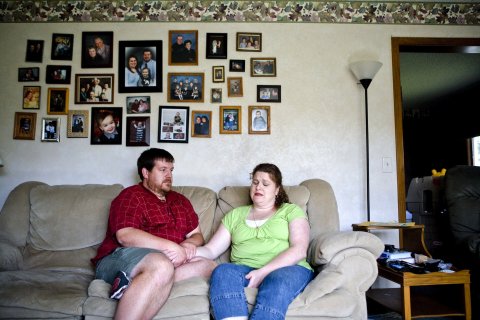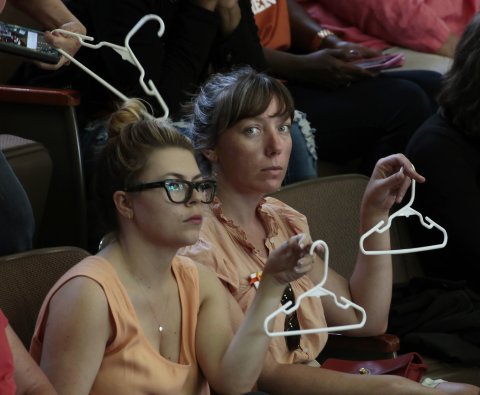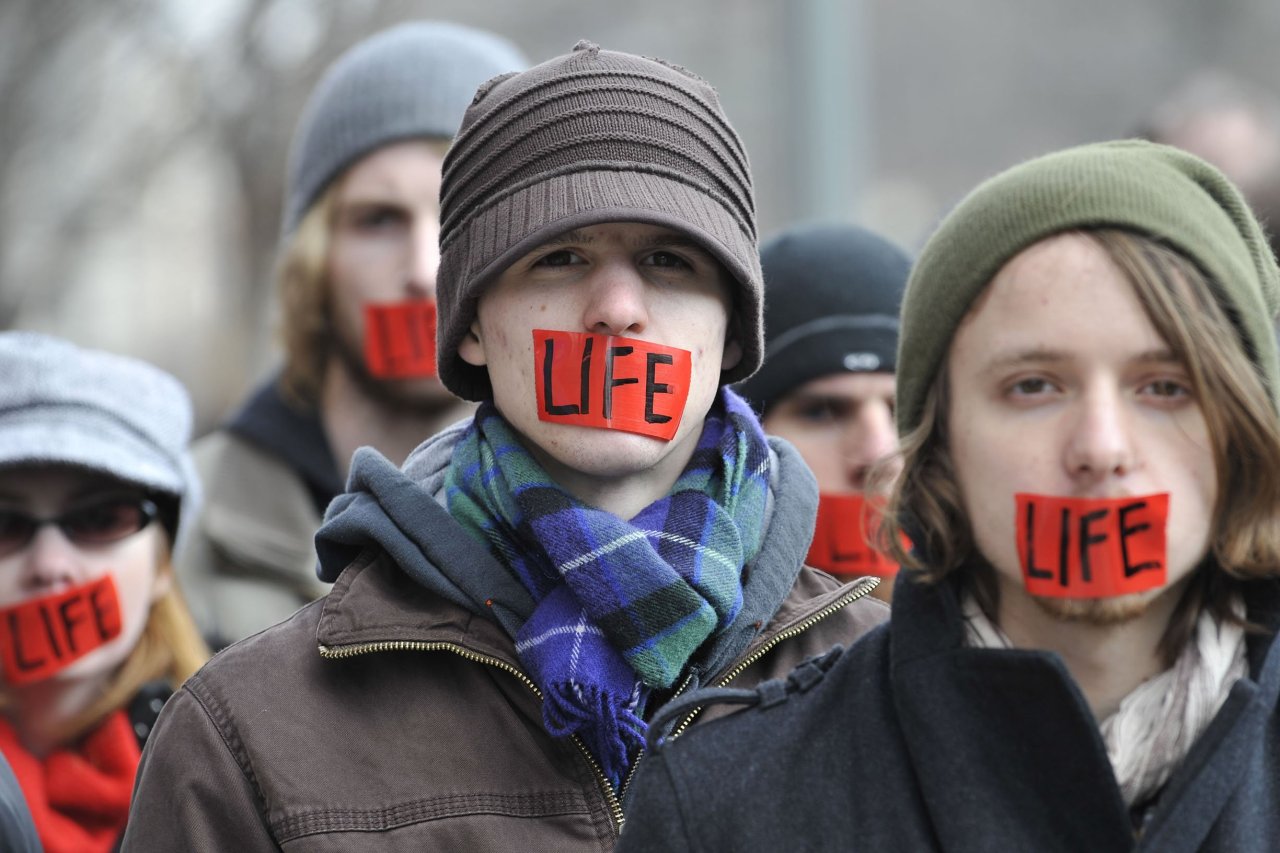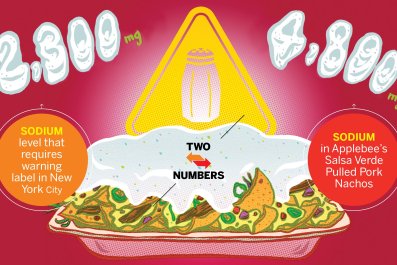I am opposed to abortion. I believe women have the right to choose.
This is not a contradiction.
Unfortunately, in a country torn apart by absolutists, the abortion wars are stuck in a brutal stalemate. Both arguments are infused with hypocrisy, and consequences often go unconsidered while bumper-sticker logic prevails. Making it worse are politicians who use abortion as reliable red meat for their supporters—both liberal and conservative—by continuing to beat the same drums America has heard for decades.
Attempts to cut this Gordian knot are often dismissed out of hand, with the motives of the messenger attacked mercilessly. Male commentators are frequently—and often rightfully—accused by pro-choice advocates of "mansplaining,'' a term for men telling women what to think. Anyone broaching the other side of the argument is deemed a baby killer, even when such hyperbole spawns murders like the ones at a Planned Parenthood in Colorado last month. But the reality is, neither side looks for a solution; they have simply descended into maudlin intellectual ping-pong, knocking the same claims back and forth, year after year. Those who are pro-choice believe, correctly, that all people have rights regarding their bodies. By that logic, an embryo or fetus is part of a woman, and she retains the right to make decisions as to whether she will bring that pregnancy to term. On the flip side, anti-abortion proponents argue that since every person alive was granted the right to be born, those who argue that life should be denied to others through an abortion are violating the golden rule.
Related: 'I Am Guilty!' Accused Planned Parenthood Shooter Robert Dear Belts Out in Courtroom
But public policy is not a philosophy class. Decades of listening to activists scream at each other proves that answers will never come from them. Instead, the rational middle has to examine the hypocrisy and flaws in the activists' positions and finally bring this war to an end.
Kill the Famous Violinist?
A building is on fire. On one floor, five healthy babies are in cribs. On another, 10,000 embryos are in petri dishes, being grown for 10,000 women who want them implanted (new scientific advances guarantee that all the embryos will survive until birth). Because of the rapidly advancing flames, you have time to evacuate only one floor: Either five babies will die or 10,000 future humans will be destroyed. Which do you choose?
Hopefully, the answer is obvious—anyone who decides to rescue globs of cells over living, breathing babies is a monster. But this hypothetical exposes the absurdity of the claim that women who choose abortion are "murdering" babies or that a human being pops into existence at conception, even though a zygote or embryo is no more sentient than a sperm.
Now change the numbers. Three babies and 1,000 fetuses at 21 weeks' gestation. Again, all of the fetuses would survive to birth. Which do you choose—the three babies or the 1,000 fetuses? Or how about two babies versus 40 fetuses at 32 weeks, when both the babies and the fetuses could feel pain? What's your choice? Change it one last time: one healthy baby or five fetuses at full term, 40 weeks. Now which do you choose?
This scenario shows how the moral issues surrounding abortion transform as a zygote grows to an embryo to a nonviable fetus, to a viable fetus, to a conscious being that could be born at any minute. The moral balance shifts as a fetus evolves, which is why viability was the standard adopted by the landmark case of Roe v. Wade, which recognized women's right to abortion.
Related: Four Decades Later, Roe v. Wade Is Still Monumental
While it's hard to believe, given the constant arguing about third-trimester abortions and fetal heartbeats, about 90 percent of abortions occur in the first 12 weeks of pregnancy; about 1.3 percent take place after the 21st week. And that 1.3 percent includes extremely complex circumstances, such as when a fetus has an incurable, dreadful disease or the mother is at risk of death.
A different hypothetical—crafted by Judith Jarvis Thomson, a prominent moral philosopher who is professor emerita at MIT—strikes at the heart of another issue in this debate. Imagine a woman goes out for the night, and a stranger knocks her unconscious. When she awakens, she finds she has been hooked up to a famous violinist who must depend on the woman for life support. The woman has been placed in this circumstance without her consent. Thomson argues that the woman has the right to unhook herself should she choose, even if it means the death of the famous violinist.
That imaginary situation, of course, addresses the issue of rape. For a rape victim to be impregnated against her will, forced by law to carry the fetus, then forced into motherhood, is no different than requiring that unfortunate woman to remain hooked up to the violinist against her will. The woman's body is being used as sustenance for another without her playing any role in the decision; the choice of what to do—with the violinist or the pregnancy from rape—is hers alone.
There is a reason to use hypotheticals in emotional debates like the one about abortion: intellectually honest combatants can't fall back on standard talking points. Sweeping declarations, such as the claim that embryos are babies, are exposed as nothing more than hot air when a hypothetical applies them literally. So one more. A pregnant woman is opposed to abortion and wants the child. But her water breaks at 22 weeks, meaning there will not be enough amniotic fluid for the fetus's lungs to develop. This innocent baby would have no possibility of living and would be in agony for as much as 15 minutes before dying. Which do you choose—an abortion or a newborn's excruciating death?
I lied. This is not a hypothetical. It happened in 2010 to Danielle Deaver, a resident of Grand Island, Nebraska. Unfortunately for her, Nebraska had passed a law declaring all abortions after 20 weeks illegal, so she was not allowed to decide what was best for her daughter. Since inducing birth would have been considered an abortion, Deaver was forced to carry her doomed child for 10 days. After the birth, Deaver held Elizabeth, her daughter, as she suffocated, one of the most terrifying and torturous ways to die.

Anti-abortion activists who never met the Deavers expressed remorse about the death but celebrated the fact that they had forced a decision on a woman they did not know. "Isn't it more humane for the baby to die in a loving manner with comfort, care and in the arms of her parents than by the intentional painful death through abortion?" Julie Schmit-Albin, who heads Nebraska Right to Life, said at the time. In other words, strangers—who, by ignoring the science that shows a 22-week fetus does not feel pain in an abortion while proclaiming that a baby's agonizing death by suffocation was one of "comfort," revealed they have no comprehension of medicine—felt justified in using the law to decide what was best for Elizabeth, without regard to her mother's wishes.
The trauma transformed Deaver from an abortion opponent to a supporter of women's choice. She sent a letter telling her story to legislators and governors in states considering the 20-week abortion ban. "When asked about my circumstances, the author of Nebraska's law said it worked as intended,'' she wrote. "This is not about politics, it's about leaving the practice of medicine up to doctors and most importantly, it's about trusting women to make the best decisions for themselves and their families."
She added, "That my pregnancy ended, that choice was made by God. How to handle the end of my pregnancy, that should have been private."
Kill the Poor?
Abortion will never be stopped. That is one of the few indisputable facts in this debate.
One of the worst conceits of the anti-abortion movement is the belief that, if only enough laws are passed, abortion will end. It is a theory espoused by people too ignorant or too disinterested to study history. Roe v. Wade was decided in 1973, which means only people over 60 might even remember what it was like when abortion was illegal in America. Based on surveys, the best estimates are that somewhere between 200,000 and 1.2 million illegal—and often unsafe—abortions were performed in the United States each year in the 1950s, according to Dr. David Grimes, former head of the abortion surveillance branch at the Centers for Disease Control and Prevention and author of the acclaimed book Every Third Woman in America. According to the Guttmacher Institute, a health research group, about 1.1 million abortions were performed in 2011—fewer than the highest estimate for illegal abortions during the 1950s, despite the fact that the country now has a much larger population.
This tells us that making abortions illegal or more difficult to obtain will not necessarily decrease the number of terminated pregnancies. According to the Texas Policy Evaluation Project—researchers from the University of Texas and three other universities and health institutions—international evidence shows that countries with onerous rules against terminating a pregnancy have a higher number of unsafe and illegal procedures, and the number of abortions is not reduced.
And some massive religious revival will not change those numbers. According to Lifeway Research, which provides analysis to church leaders, 70 percent of the women who have had an abortion identify themselves as Christians; 3 percent say they are Jewish, and 4 percent are atheists. About half of the Christian women surveyed—36 percent of all women who had a pregnancy terminated—were attending church once a month or more.

The point is, for all the Sturm und Drang by the anti-abortion activists over what many of them call the number of babies "murdered" since Roe, there is no reason to expect that those statistics would be lower if abortion had remained illegal. And remember, none of the statistics for illegal abortions in the 1950s account for the wealthy women who traveled to countries where the procedure was legal and safe. (The same will apply if abortions are made illegal tomorrow; anyone who can afford a trip to Mexico can access misoprostol, which causes early abortion and is available there, usually without a prescription.)
And make no mistake: Laws prohibiting abortion kill people. Grimes's research showed that during the 1940s more than 1,000 women were known to have died each year from complications caused by an illegal abortion, although the true number was much higher. Every large hospital maintained a "septic abortion ward" for infected women with incomplete terminations.
This underscores why the anti-abortion movement cannot be called pro-life: Its members support policies without concern for all the dead bodies left in their wake. Outlawing abortion is not the only law that kills; even modern attempts to restrict abortion—often based on lies and misrepresentations—have begun to jeopardize the health of women. For example, in 2013 Texas adopted a law requiring facilities that perform abortions to have a doctor on staff with admitting privileges at a hospital no more than 30 miles away and forced the clinics to meet standards for "ambulatory surgical centers," which include onerous rules concerning buildings, equipment and staffing. The Supreme Court last month agreed to hear a challenge to the constitutionality of the law.
This rule is designed, its proponents lie, to make sure women receive top-flight medical care, even though abortions are among the safest of all medical procedures. According to a 2012 study by the journal Obstetrics and Gynecology, about 9 women out of every 100,000 died in childbirth, compared with 0.6 who died from an induced abortion. The rate of major complications is lower than 0.5 percent. Compare that to testosterone supplements: According to JAMA, the journal of the American Medical Association, men are 29 percent more likely to die, or have a heart attack or stroke, after just three years of use. Yet testosterone can be purchased online or at the neighborhood drugstore.
So while Texas politicians lie that they are protecting the health of women whose health is not threatened, they accomplish their true goal: making it virtually impossible for many women to get a legal procedure. Over half of the more than 40 facilities providing abortion care in the state have closed since 2013 because of the law. If the Supreme Court fails to strike down the law, there will be just 10 facilities by the end of 2016, all clustered in large metropolitan areas. The result: More women will likely attempt to induce their own abortions because of the shutdowns, according to the Texas Policy Evaluation Project, which concluded that as many as 250,000 Texas women have done so in recent years. The researchers found that self-induction appears to be most common among Latina women near the Mexico border and women who confront obstacles in reaching reproductive health services.
Abortion opponents, whether out of ignorance or obsession, have grown accustomed to lying in order to advance policies or block abortions, with complete disregard for consequences. Lie about wanting to improve women's health, force clinics to close, and more women are likely to die.
Then comes the most recent falsehood told to shut down women's health clinics: secretly recorded videos edited to make it sound as if Planned Parenthood were illegally selling fetal tissue for a profit; it wasn't. Instead, the organization was asking women who had just had abortions if they would be willing to donate tissue samples to medical research. As the unedited tapes make clear, Planned Parenthood was receiving reimbursement for the cost incurred in getting the tissue to researchers. Yet politicians and activists have played on the public's unfamiliarity with issues involving fetal tissue, falsely proclaiming that Planned Parenthood is selling body parts, even though no one can explain why anyone would need a baby's arm or brain.

The truth is much less dramatic. Medical researchers have been using fetal tissue for almost a century, and almost everyone in this country has a better life because of that work. Anyone who received vaccines against rubella, polio or chicken pox benefited from medical work with fetal tissue. This research has saved millions of lives.
The current system for collecting and using fetal tissue emerged after lengthy debate. President Ronald Reagan appointed the 1988 Fetal Tissue Transplantation Panel to examine the ethical issues surrounding its use. The panel's recommendations were largely adopted in 1993, when Congress passed the National Institutes of Health Revitalization Act. The law included significant consent requirements to separate the mother's decision on termination from the choice of whether to donate fetal tissue, and criminalized its sale or purchase but allowed reimbursement of expenses for institutions that collect, store and transport it. In other words, politicians and activists are now outraged by recordings showing Planned Parenthood doing what Congress intended.
Now Republican members of Congress are calling for all federal funding of Planned Parenthood to be cut off because of those deceptive videos. Once again, the consequences of trying to stop abortions are being ignored. According to its 2013-2014 annual report, Planned Parenthood conducted 4.5 million tests for sexually transmitted diseases that year, provided various kinds of contraception 3.6 million times (which of course prevented millions of potential abortions), administered almost 1 million cancer screenings and delivered more than 1 million other health services to patients. It also performed 328,000 abortions, about 3 percent of its total activity.
Abortion activists and political leaders want the 97 percent destroyed to strangle that 3 percent. They never say where the millions of poor people who depend on Planned Parenthood for their health care can turn.
The After-Birth Movement
In this debate, choice is a lie. Abortion is a luxury available only to those who can afford it.
The freedom to choose an abortion also means the freedom to choose birth. Unfortunately, America spends so much time wringing its hands over theoretical inducements that might play a role in whether some well-off person chooses an abortion—such as feeling altruistic about contributing fetal tissue to medical research—that it does nothing about the issue that most directly leads to the highest incidence of abortion: poverty.
Consider these statistics: According to the Guttmacher Institute, the abortion rate decreased 8 percent from 2000 through 2008. But the numbers look very different when broken down by financial status. For poor women, rates climbed by 18 percent, while women with high incomes saw a huge decline of 24 percent. The incidence of unintended pregnancies—something that can be limited by clinics like Planned Parenthood that provide birth control—saw a similar socioeconomic split: From 1994 to 2008, the number of such pregnancies among poor women skyrocketed by 55 percent; for more wealthy women, they dropped 24 percent.
What this means is that an increasing number of poor women are getting pregnant when they do not want to, which undoubtedly contributes to their higher rate of abortions. In fact, 42 percent of the women who decide to terminate pregnancies earn less than $10,800 a year, which puts them below the federal poverty line for a single woman with no children; 7 out of 10 women who undergo an abortion make less than about $22,000.

But that does not mean all of these women would choose to have an abortion in different financial circumstances. In fact, the most frequent reasons given by women for terminating a pregnancy are financial. In a survey conducted in 2004, three-quarters of the women who chose an abortion said it was because they did not have the financial ability to care for a child. Three-quarters also said that having a baby would interfere with their ability to work, go to school or care for other dependents.
Despite all the polls and surveys on abortion, no prominent study has explored whether removing the primary reason given for terminating a pregnancy would decrease the number of abortions. But there is no doubt that, if three-quarters of the women who had an abortion did so out of financial necessity, the number of terminations would shrink if that problem was confronted.
Which brings us to a solution.
Stop Abortions? Write a Check
Pay for it. That's the plan.
Activists on both sides of this debate need to put down their placards and open their wallets. It is too easy to stomp outside an abortion clinic, screaming at patients before heading home for a nice dinner. But if told they could prevent the "murder of babies" by shelling out more in taxes and signing up to be adoptive parents, how many of them would do so without complaint? And if pro-choice advocates believe women should be allowed to make their decisions about pregnancy without outside pressure, how many of them would agree to cough up more cash so poor women could choose to keep their babies?
Many of the women who terminate pregnancies after 12 weeks report they did so because it took that long to raise the money for the abortion. No reasonable person would think someone under that kind of financial stress could afford complete prenatal care, including vitamins, checkups, frequent sonograms and the rest. Nor could anyone rationally believe she would have enough money for diapers, formula, cribs and toys—much less clothing and food as the child grows—without keeping her job and earning more money. But that raises the question of who will care for the child if the mother goes to work.

The old line is that conservatives care about children up until the day they are born, but until all of us show more concern for the child than for the fetus, there is no chance of cutting back on abortions, regardless of the law. And pro-choice advocates—who are often portrayed as caring only about making abortion readily available—must also commit to helping those poor women who want to give birth.
Here are all the new costs:
- The minimum wage will have to be increased; every time this has been advanced, conservatives have complained that it will cost jobs. And yet jobs kept growing every time the wage went up, because people had more money to spend, which in turn meant more business and more jobs. Poorer women would be more likely to give birth if they had greater financial security.
- We must offer government-funded day care. In our current system, poor women struggle to find places to leave their kids; many low-income jobs now have on-call requirements, meaning an employee can be told to show up to work at almost any time. No mother has that kind of flexibility. With free day care, poor women would have more support if they choose to give birth.
- Any woman who wants to keep her baby should be guaranteed quality prenatal care at no charge. All physicians will be required to explain the need for such care and provide additional education to increase the number of mothers who obtain regular checkups and follow prenatal nutrition recommendations. This program does not necessarily need to be paid for directly by taxpayers. A national network should be established linking couples who want to adopt—many of whom will hopefully come out of the anti-abortion movement—with women who choose to give birth. Those couples would be required to pay for all prenatal care and hospital expenses. Moreover:
- Laws will have to be strengthened to ensure that employers pay a huge price for any attempt to drive away a pregnant worker.
- Finally, stop fighting Obamacare. In the words of Charles Camosy, a Christian ethicist, the Affordable Care Act is "the most important development since 1992" in alleviating burdens on pregnant women. Not only does it provide expanded health benefits for poor women, but it also has been proved to decrease the uninsured rate. What difference does it make if a child is born if it dies of an asthma attack for lack of the money needed for an inhaler? The statistics show that many poor women worry about being unable to provide a good life for their child. Telling expectant mothers that their children will be uninsured—and thus might not be able to obtain adequate health care—is certainly a pressure that could lead a woman to choose an abortion.
Many anti-abortion advocates who also oppose Obamacare apparently don't know what's in it: The law includes provisions of the Pregnant Women Support Act, which these activists pushed for many years. It increases the tax credit for adoption, requires insurers to cover prenatal care, makes grant money available to the states for pregnancy counseling and home visits by nurses, and establishes an array of other benefits designed to help pregnant women.
These sensible and humane steps won't stop all abortions. The complex balance between a woman's autonomy and a fetus's chance at life poses an unresolvable question, one where both sides of the moral equation must be respected. But these measures would guarantee that fewer women would be forced by financial pressures to seek an abortion, giving them true freedom of choice. The plan's not perfect, but it's better than what we have. And if either side whines about higher taxes—or if anti-abortion activists refuse to adopt babies who otherwise might have been aborted—at least we will finally know that their years of protests have been a charade.






















